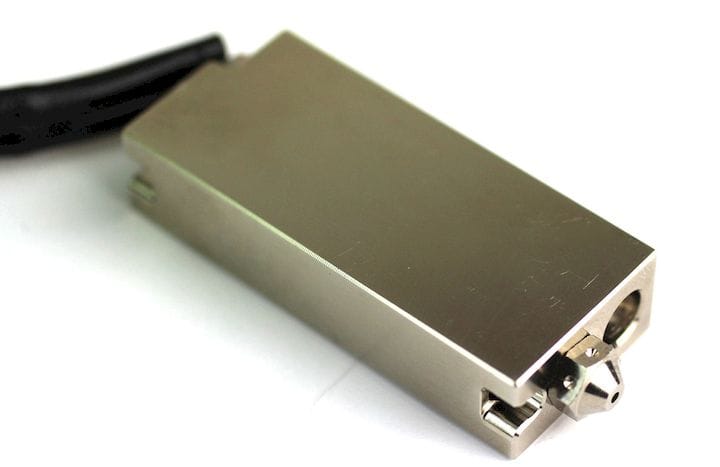![The new SuperVolcano 3D printer hot end [Source: E3D]](https://fabbaloo.com/wp-content/uploads/2020/05/supervolcano-ov_result_img_5eb09b9a93bb4.jpg)
UK-based E3D-Online announced their latest — and largest — 3D printer hot end, the SuperVolcano.
E3D has become one of the de facto standard parts suppliers for key elements of many desktop 3D printers produced today. Their highly reliable V6 hot end appears in countless machines. But the company isn’t set on standard style components. They have for some years marketed the Volcano, a larger-sized hot end capable of additional material flow. But now that seems to be superseded by the incredible SuperVolcano.
This is a hot end replacement for desktop (or larger) 3D printers requiring massive material flow. How much flow, exactly? Apparently the new SuperVolcano can emit no less than 11X the material of their V6 hot end within the same time period. Their specification indicates a maximum flow of 6600 mm3/min, or about a liter every 2.5 hours. That’s a massive amount of material!
Designing a large-volume hot end such as this is quite a challenging project, as there are many concerns. In order to increase the flow, material has to pass through more rapidly. But that means you must lengthen the heat path to ensure the material is exposed to heat for a sufficient time. But that means you need to heat more volume, requiring more power.
E3D was concerned about the power required, and thus included a Mosfet switch in the design that could handle higher current flow.
They also chose not to use aluminum as the material for the heater block, as they felt it might actually soften when exposed to all the heat required on the SuperVolcano. Instead they’ve chosen to implement a nickel-plated copper block.
![Sample 3D print made with the SuperVolcano hot end [Source: E3D-Online]](https://fabbaloo.com/wp-content/uploads/2020/05/image-asset_img_5eb09b9b02e62.jpg)
Similarly, their normal sock has been replaced with a specially designed high-temperature fiberglass sock to help contain and maintain heat. Apparently the new sock can handle 260C continuously.
There’s a number of advantages to 3D printing with larger flow capability. Firstly, 3D prints can be completed more rapidly — at the cost of layer size — by using a larger nozzle diameter. E3D recommends using a 1.0mm nozzle for the SuperVolcano, but you can use other sizes such as 0.8mm or 1.2mm, depending on the application.
The superior material flow allows the larger-diameter nozzles to be used to full advantage, whereas lesser hot ends might not be able to provide enough material to warrant their use. E3D provided a chart on their blog post showing the true speed increase with a variety of nozzle sizes, but all seem quite impressive.
The other interesting factor is that the fatter extrusion lines will provide more surface area for increased inter-layer adhesion. This should make prints stronger, and even provide better first layer adhesion to the print bed.
![#3DBenchy 3D print samples made on various hot ends [Source: E3D]](https://fabbaloo.com/wp-content/uploads/2020/05/image-asset_img_5eb09b9b46efd.jpg)
Finally, while the stock SuperVolcano can run at 285C, E3D says that by changing the thermistor for a thermocouple, you should be able to 3D print at an incredible 400C, suitable for materials like PEEK. It seems that E3D has designed the SuperVolcano to be high-temperature capable.
This all sounds very interesting, and will be of great value to those who wish to upgrade their existing equipment to be able to 3D print very large objects far more quickly. But there’s something else to happen here, too.
I think that the availability of this powerful hot end could trigger the development of a new wave of large-format 3D printers. Up to now the large-format market has been dominated by a few specific 3D printer manufacturers who have each produced their own specialized hot ends and extruders. Now it is possible they may be challenged by a number of other companies who have been interested in exploring that market but required a reliable large-volume hot end.
The SuperVolcano is now available in kit form at a price of £80 (US$106).
Via E3D











